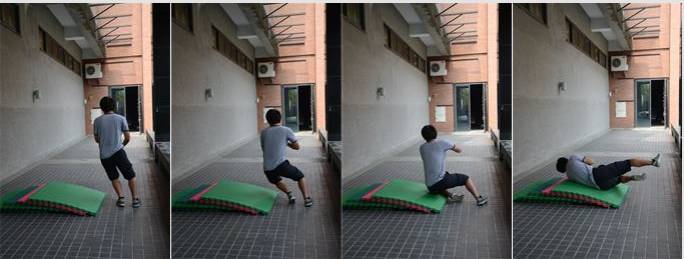Falling alarm system
Assistant professor Wen-Pin Hu in our department cooperated with Footdisc Inc. to perform an industry project from January to May in 2013. The aim of this project is to develop a falling alarm system. Because elderly population is increasing in global and unintentional fall is a common cause of severe injury in the elderly population. According to the report [1], over a third of adults ages 65 years and older fall each year. Among these falling events, 55 percent of fall injuries occur inside the home and 23 percent occur outside, but the locations are close to home [2]. Therefore, the issue about how to develop a reliable and accuracy falling alarm for elderly population is a hot topic since the last decade. The advanced wireless sensing technology and network promotes and supports to achieve this application. In this project, we adopts XBee modules to wireless transmit the sensing data, and a computer is used to receive and analyze incoming data. Accelerometer (g-sensor) is a commonly used sensor to detect the motion of an object, and is also applied in the fall detection. However, the best accuracy for determining fall events by solely using an accelerometer is around 90%. Footdisc Inc. sales functional insoles and incorporates biomechanics in designing insole products. For example, the insole called as currexSole can relieve knee, foot and back pain, whilst being comfortable to wear as well. In this project, we embedded a pressure sensor into the insole to measure the pressure values of feet in daily activities. The pressure values are used to help decide the falling events. Based on the experimental data in this project, we found that the combination of signals from an accelerometer and pressure sensors indeed improved the accuracy in determining fall events. The developed falling alarm system is suitable used in the nursing home and the elderly population who took the home health care.

Figure 1. One of the experimental motion : falling to one side
[1] M.C. Hornbrook, V.J. Stevens, D.J. Wingfield, J.F. Hollis, M.R. Greenlick, and M.G. Ory, ”Preventing falls among community-dwelling older persons: Results from a randomized trial,” The Gerontologist 1994:34(1):16-23.
[2] A. Kochera, ”Falls among older persons and the role of thehome: an analysis of cost, incidence, and potential savingsfrom home modification,” AARP Public Policy Institute, 2002, http://research.aarp.org/il/ib56 falls.pdf.
Efficacy Evaluations of Air Filtration Made of Antibacterial Polypropylene Melt-Blowing Nonwoven Composites
Distinguished Professor Ching-wen Lou in our department cooperated with Hsinnjy Ltd. Co. to perform an industry project from June 2018 to May 2019. The aim of this project is to development of air filter fabrics featuring high filtration and antibacterial efficiencies. This project is divided into three stages. The first stage involves with the manufacturing design and material selection for the air filtration. Polyester (PET) and low-melting-point (LMP) fibers are blended and undergo a nonwoven manufacturing then the hot pressing process, forming nonwoven matrices. The thermally bonded nonwoven matrices have higher density of and greater friction between fibers, and thus are mechanically reinforced. The matrices are tested for related assessments and the test results analyzed for optimal parameters of PET/LMPET air filtration. The second stage involves with the manufacturing design of antibacterial polypropylene (PP) melt-blowing nonwoven fabrics. PP polymer masterbatches are used as the basis of nonwoven fabrics. Triclosan is then added to obtain antibacterial efficacy, thereby creating high filtration and antibacterial efficacies and determining the optimal parameters of melt-blowing nonwoven fabrics. The last stage involves with the manufacturing design of air filtration fabrics. The melt-blowing is employed to cover the optimal melt-blowing antibacterial PP melt over the non-thermally-treated PET/LMPET nonwoven fabrics. The materials are then processed with hot pressing in order to form antibacterial PP/PET/LMPET air filtration. It is expected that the resulting products are helpful with better air quality in any spaces, providing high performance filtration and antibacterial efficacy.
[1] Ferreira, T.M., et al., Effects of particulate matter and its chemical constituents on elderly hospital admissions due to circulatory and respiratory diseases. International journal of environmental research and public health, 2016. 13(10): p. 947.
[2] Sim, K.M., et al., Antimicrobial nanoparticle-coated electrostatic air filter with high filtration efficiency and low pressure drop. Science of the Total Environment, 2015. 533: p. 266-274.
[3] Kamalipour, J., et al., Preparation and release study of Triclosan in polyethylene/Triclosan anti-bacterial blend. Colloids and Surfaces B: Biointerfaces, 2016. 145: p. 891-898.
Industry-university cooperative research project
Polysaccharides purification and cosmetic product development from Auricularia auricula-judae (cooperation between Rouh-Mei Hu, Asia University and Wu-Feng District Farmers’ Association)
Brief introduction: Auricularia auricula-judae also known as black fungus or wood ear is a common edible mushroom in Asia region. The fruit body of A. auricular-judae is rich in water-soluble polysaccharides that can be used in in food, pharmaceutical and cosmetic industries. Wu-Feng District is famous in its Mushroom cultivation and mushrooms were one of Taiwan’s first successful export products. Black fungus is one of the most important mushroom product in Wu-Feng. In this cooperative research project, Asia University established the purification protocol of polysaccharides purification from Black fungus, determined the bioactivity of the purified polysaccharides and helps to develop face musk using black fungus polysaccharides as one of the main ingredients.





